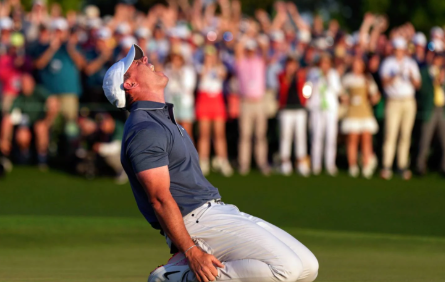After going through an emotional roller coaster, Rory McIlroy rolls in the winning putt in sudden-death playoffs against Justin Rose, joining Gene Sarazen, Ben Hogan, Gary Player, Jack Nicklaus, and Tiger Woods as the only golfers in history to win all four major championships.
The events that unfolded on the second nine on Sunday gave us one of the best finishes in the history of the Masters. After shooting one under through the first nine, McIlroy had a four-stroke lead. He was in this same situation going into the second nine of the 2011 Masters but fell apart after hitting a terrible tee shot on 10. This was his opportunity for redemption.
He opened up the second nine with respectable scores of a birdie on 10, a bogey on 11, and par on 12. Coming to the back end of Amen Corner, victory seemed inevitable for McIlroy, especially after his closest pursuer, Dechambeau, hit his approach shot into the water on 11. McIlroy’s strategy started to become more passive, favoring safer, more conservative shots. This yielding mindset may have set him up for his worst shot of the tournament. On his third shot of the Par 5 13th, he hit the ball way on the toe, missing 20 yards right, causing the ball to land in the water. Meanwhile, 2013 US Open winner Justin Rose was on a roll, birdieing seven of his last 11 holes. Upon double bogeying 13 and single bogeying 14, McIlroy now found himself one stroke behind Rose. Within 30 minutes, McIlroy had gone from a comfortable four-stroke lead to trailing. However, unlike many of his prior career moments, McIlroy didn’t fold under the pressure. He came into 15 with an aggressive mindset, hitting arguably one of the best approach shots of the tournament. With 207 yards to the pin, water at the front of green, a death trap of a slope at the back of the green, the ball below his feet, seven iron in hand, McIlroy hits a high draw around the trees swinging way right to left rolling 6 feet from the pin for a chance at eagle. Though it only resulted in a birdie, Rory now had his confidence back. After scoring par on 16 and a birdie on 17, McIlroy was one stroke ahead of Rose and just needed a par on 18 for the win. After hitting a perfect drive, he was 125 yards from the pin but didn’t turn over on his approach shot, putting him in the right bunker. After getting out of the bunker, he had a makeable par putt but missed it and just left, forcing a playoff with Rose.
Entering the playoff on 18, both players hit blistering drives right down the middle. However, McIlroy’s skill set played to his advantage, for he outdrove Rose by over 30 yards. Rose’s approach nearly hit the pin and rolled out to a manageable distance, putting all the pressure on McIlroy. With everything on the line, McIlroy took his gap wedge and hit a near perfect shot within four feet of the pin. After Rose two-putted for par, McIlroy had a short put for the win. He stood over the putt and drained it right down the middle. He had done it. He won his first green jacket.
After he made the putt, McIlroy fell on his knees and started crying. We don’t see that often from athletes, and that displays the true magnitude of this moment and what it means to him. He has always been vulnerable to the media criticizing him for not performing well in the clutch, and when that putt went in, all the stress was pulled off his shoulders.
Just like the final day, the whole week was full of ups and downs for McIlroy. He started out the week strong on Thursday, scoring four under with no bogeys after fourteen holes. However, his issues started when he hit his second shot over the green on the Par 5 15th and subsequently chipped it into the water, scoring a double bogey. His issues for the day would not stop there, for he scored another double bogey on 17 in similar fashion, finishing the day even par. It rained the Monday before the Masters at Augusta, which most likely caused the greens to be firmer, resulting in more rollout than McIlroy anticipated. From the same spot, well-renowned player Patrick Cantley had previously dumped two consecutive chips into the water, showing the sheer difficulty of the shot.
Importantly, the theme for McIlroy in this tournament was that whenever he faced any hardship, he always came back stronger. Through round two and three, he came out firing. Everything was going his way, every aspect of his game seemed spot on. For both rounds two and three, McIlroy scored six under, giving him the two stroke lead at 12 under going into Sunday.
Going into Sunday, McIlroy was paired with Bryson Dechambeau in the final pairing. Dechambeau has gained popularity on YouTube with his Break 50 challenge, where he scrambles with many celebrities, most notably President Donald Trump, to try to break 50. These two players had a history that went back to the 2024 U.S Open. In that tournament, McIlroy had a two-shot lead going into the final holes, but he bogeyed three of his last four holes, allowing Dechambeau to come back and steal the win. Dechambeau came into Sunday only two strokes down and took the lead over McIlroy after hole two when McIlroy double bogeyed the first hole. However, Dechambeau was consistently making mistakes while turning his ball too far from right to left, which put him out of contention in the second nine.
Second-place finisher Justin Rose was coming into the Masters looking for his first win after coming in second at the 2015 and 2017 Masters. Rose’s scorecard was mostly inverted compared to McIlroy’s throughout the week. He was well in the lead after Thursday, shooting the lowest round in the whole tournament of seven under. However, his troubles started through the second and third rounds, shooting a combined two over par. Everybody counted him out on Sunday, but he came roaring back with a huge load of birdies. He was a mere inches away from making his birdie putt in the playoff and forcing a second playoff hole with McIlroy, but he will have to settle with yet another second-place finish at the Masters.
World number one Scottie Sheffler had a pretty poor week for his standards finishing fourth in the tournament with a score of eight under. Sheffler was the defending champion and was by far the favorite to win the tournament coming in. He had a solid first round of four under, but struggled to stay consistent in round two and three putting him out of reach on Sunday.
While the field is packed with talent and storylines, what truly sets apart the Masters isn’t just the high-level play; it is the environment that surrounds it. The course the Masters is played on, Augusta National in Georgia, is the defining part of the Masters. In a media-filled world where phones are present everywhere, Augusta stays rooted in tradition by enforcing strict rules for all spectators that ban phones, running, and sitting on the ground. In addition to this, the language of the broadcast is heavily curated: all fans are recognised as patrons rather than fans, the rough is called the second cut, and the front and back nine holes are referred to as the first and second nine. Each hole is also named after a type of plant, adding to the natural feel of the course. All these elements are set in place to create an atmosphere that feels authentic and meaningful.
The lack of technology present among the patrons is truly unique in today’s age because it allows the patrons to truly live in the moment rather than recording it on their phone.
For all its history, golf has been known as one of the most lucrative sports, but surprisingly, the Masters is far from profitable. The Masters don’t make a single penny for their domestic broadcasts, while other tournaments like the US Open are making over 150 million by selling their broadcasting rights. Having the full rights to the broadcast allows the Masters to have more control over what they show, which can result in things like reduced advertising. All other big sporting events are plastered with logos and slogans of sponsored companies, but the Masters only accept about four to five sponsors every year to simply cover their expenses. This results in around four minutes of advertising every hour. The food at Augusta National is also famously resistant to inflation, for you can get an egg salad sandwich for as low as $1.50. Another thing to consider is that getting tickets to watch the Masters is not easy. Around 2 million people fight in a lottery for about 160,000 tickets. Lottery tickets often cost under $200 per ticket, which is incredibly cheap for an event of this caliber. The idea behind this is that everybody should have a fair opportunity to see the Masters regardless of wealth. The downside of this system is that there are a lot of tickets that are resold for extremely high prices. The Masters is the event with the second most resold tickets in the United States, only behind Taylor Swift concerts. Ultimately, the Master’s committee isn’t focused on profit but on preserving the integrity of the tournament, ensuring a good viewing experience for all.
Although the Masters is a very competitive tournament, there were still some unserious moments to come out of the week. Ameteur Jose Luis Ballester was caught peeing in the honorable Rae’s Creek that runs through Augusta. He claimed he just really needed to pee after missing the bathrooms further back in the course. Max Homa also broke a staple golf rule in waiting for the group in front of you to clear and hit an opposing player’s caddie with one of his shots. Also, the iconic play-by-play announcer Jim Nance announced his retirement in 2036, which means we witnessed the 11th to last time we will announce the Masters.
All and all, the 2025 Masters had one of the most memorable finishes and and McIlroy’s win will most likely go down in history as a staple moment in the world of golf.




